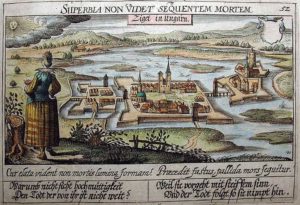The Hungarian Hussar regiments of Cardinal Richelieu, 1635

It is not widely known, that the first Hungarian Hussar unit appeared in France in 1628 during the reign of King Louis XIII (1610-1643). This traditionally Hungarian heavy or semi-heavy cavalry used to be the top quality cavalry unit of the age.
No wonder that after King Báthory István (aka Stephan Bathori) of Poland, also Prince of Transylvania had introduced the Hungarian-style Hussar units in Poland they became very popular all over Europe. Now, we are not talking about the light Hussar cavalry of the 18-19th century that everybody knows, though.

Our mounted warriors still wore armor, a special shield and helmet, wielded sabers and “estoch” (long, straight sword for piercing armor), and battle-axes. Some had their long lances but all of them were supplied with a pistol since the 1570s. Of course, each Est-European nation had its own light-cavalry tradition but Hungarian Hussars were combining the eastern and the western style very successfully. Here is an article about their horses and warfare:
https://www.hungarianottomanwars.com/essays/horses-of-battle/

King Louis XIII was watching the parade of these Hungarian warriors in the summer of 1629 and was amazed to see the Hungarians’ horsemanship who entertained him by riding their horses without a saddle. The legs and the tails of the horses were painted red which habit derived from the fights against the Turks who often painted their horses, too.
We know that Cardinal Richelieu appreciated the Hungarian efforts regarding the wars against the expanding Ottoman Empire. As for the Siege of Szigetvár Castle in 1566, he said: „It was a battle that saved civilization”. It was the famous siege where the Croatian Nikola Šubić Zrinski, the great-grandfather of the poet and general, the Croatian-Hungarian Nikola Zrinski aka Zrínyi Miklós (1620-1664) heroically stopped Sultan Suleiman, sacrificing his life, dying together with his Croatian-Hungarian warriors.

The Cardinal added:
„a miracle was needed for Europe to survive, and this miracle happened at Sziget. The question was decided at Sziget whether the cross or the crescent would leave an indelible mark for centuries on the major parts of Europe.”
Consequently, he had to know that Hussar units were the most effective cavalry units which had been able to block the Ottomans for centuries.

On the other hand, Cardinal Richelieu did not have a very good opinion of the French cavalry in general so he recommended establishing three Hussar regiments in Hungarian fashion. He expressed his opinion in his letter written to the king in July 1635. It was the time when the French army was undergoing major changes. They established 17 regiments of which 12 contained French soldiers.

Three regiments of horsemen were set up by foreigners and two regiments were supplied with short-barreled rifles.
Richelieu recommended the setting up of three more regiments and wished to call them „Cavalerie Hongroise”. It didn’t mean that the soldiers were Hungarians, except for their weapons and armor. These Hussars were supplied with Hussar-style breastplates and lobster-tail hussar helmets. They had short-barreled guns and pistols, too. Here you can read how the lobster-tail helmets were used in Hungary:
https://www.hungarianottomanwars.com/armors-and-shields/hungarian-lobster-tail-helmets/

Naturally, there were also Hungarians in these regiments but most of the soldiers were Germans, Croats, or Polish. By all means, the French people were enchanted by their attire, especially by their scarves which came quickly into fashion in Paris. The French word for „necktie” is „cravate” which derives from the word „Croat” or „hrvat”.
These Hussar units were used for patrolling and guarding the supply lines. Things changed after 1705, though: from that time on, mostly Hungarians were serving among the French Hussars. When King Louis XIII was watching admiringly the show of the Hungarian Hussars in 1629, he didn’t guess that he would only narrowly escape from the Hungarian and Croatian Hussars in 1636. As France attacked the Habsburgs in 1635, things didn’t work very well out for the French for the first time in the war. A Hungarian Hussar unit was able to raid as far as Paris where the French king was staying. The king went out for a walk and the hussars arrived just 15 minutes after his return.

(Source: Takács Zoltán Bálint, Hussar Museum of Sárvár Castle, Hungary, and Zed Zidar. Pictures: Cardinal Richelieu’s armor about 1625-1630, photos: George Steel, displayed in France Paris, @museearmee_invalides and there are also Polish and Hungarian style Hussar armors.)
In the pictures below: Richelieu’s armor compared with Polish and Hungarian Hussar armor…
Dear Readers, I can only make this content available through small donations or by selling my books or T-shirts.
If you like my writings, please feel free to support me with a coffee here:
You can check out my books on Amazon or Draft2Digital, they are available in hardcover, paperback, or ebook:
https://www.amazon.com/dp/198020490X
or at https://books2read.com/b/boYd81


My work can also be followed and supported on Patreon: Become a Patron!http://Become a Patron!














